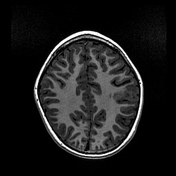Items tagged “mri”
786 results found
Case
Large broad ligament leiomyoma

Published
06 Dec 2016
92% complete
X-ray
MRI
Case
Chronic ischiofemoral impingement

Published
19 Jan 2017
95% complete
MRI
Case
Adhesive capsulitis - shoulder

Published
19 Jan 2017
92% complete
MRI
Article
ADIR position
The ADIR (ADduction and Internal Rotation) position relates to MR arthrography of the shoulder joint.
When added to a neutral-position shoulder protocol, MR arthrography in the ADIR position facilitates the diagnosis of labroligamentous lesions in patients with recurrent shoulder dislocations, ...
Article
Magnetization transfer
Magnetization transfer (MT) imaging is an MRI technique that can be used to exploit the contrast between tissues where 1H protons are present in three states1:
bound to macromolecules
in free water
as water in the hydration layer between the macromolecules and the free water
To assess MT, an...
Article
Eddy currents
Eddy currents (also known as Foucault currents) are the result of rapidly changing gradient magnetic fields that in turn induce stray currents in the surrounding conducting materials. They form in accordance to Faraday's Law of Induction.
Eddy currents are unwanted as they generate their own ma...
Case
Left parietal lobe ganglioglioma (grade I)

Published
28 Sep 2017
75% complete
Annotated image
MRI
Article
Tesla (SI unit)
The tesla (symbol T) is the derived SI unit of magnetic flux density, which represents the strength of a magnetic field. One tesla represents one weber per square meter. The equivalent, and superseded, cgs unit is the gauss (G); one tesla equals exactly 10,000 gauss.
Most current medical magnet...
Article
Nuclear magnetization
Nuclear magnetization refers to the magnetic moment of an atomic nucleus. Magnetic resonance imaging (MRI) makes use of nuclear magnetic resonance (NMR). Some nuclei may have nuclear magnetization depending on their nuclear charge distribution and the spin of their protons and neutrons. Nuclei w...
Article
Magnetic susceptibility
Magnetic susceptibility is the ability of external magnetic fields to affect the nuclei of an atom. This may also be thought of as the “magnetisability” of a material, or the extent to which a material becomes magnetized when placed in an external magnetic field.
Magnetic susceptibility is rela...
Article
Dependence of magnetization (proton density, field strength and temperature)
The dependence of magnetism is based on proton density (PD), field strength and temperature. There is a frictional interchange of energy between the protons and the lattice (spin-lattice interaction), such that a balanced exchange occurs between the two energy states and the thermal equilibrium ...
Article
Longitudinal and transverse magnetization
Longitudinal magnetism and transverse magnetism are components of the net magnetism vector.
Longitudinal magnetism
Longitudinal magnetization is the component of the net magnetization vector parallel to the magnetic field (z-axis). This is due to a difference in the number of spins in parallel...
Article
Electromagnetic induction
Electromagnetic induction is the induction of electric current via changing magnetic fields. Magnetic fields are generated by moving charges (equivalent to electrical current). Ampere’s law or Fleming’s right-hand rule determines the magnitude and direction (i.e. clockwise or anti-clockwise) of ...
Article
T1 values (1.5 T)
T1 values are a few hundred milliseconds (ms) for most tissues examined.
The following are approximate T1 values (ms) of several tissues for B0 = 1.5 T
fat = 260
liver = 500
muscle = 870
brain white matter = 780
brain grey matter = 920
CSF = 2500
Tissues that will have high signal on T1-...
Article
Factors affecting T1
Factors affecting T1 and T2 relaxation times of different tissues are generally based on molecular motion, size and interactions.
The protons giving rise to an NMR signal are mainly those in cell water and lipids (i.e. protons that are free to move), while those in protein and solids usually do...
Article
Molecular tumbling rate effects on T1 and T2
The average rate at which molecules tumble (and therefore T1 and T2 time) is related to the molecular size. Small molecules (e.g. water/CSF) have a broad distribution of motional frequencies with poor matching with the Larmor frequency and therefore have long T1 values. Medium sized molecules (e...
Article
Chemical shift
The chemical shift is the local change in resonant frequency due to different chemical environments. The external magnetic field causes the electron cloud surrounding the nucleus to induce an electron current, which in turn produces a local magnetic field at the nucleus opposed in direction to t...
Article
Proton density weighted spin-echo images
Proton density (PD) weighted images are related to the number of nuclei in the area being imaged (number of hydrogen protons), as opposed to the magnetic characteristics of the hydrogen nuclei. They are produced from the first echo. Proton density weighted images result when the contribution of ...
Article
Fast spin echo
Fast or turbo spin echo (FSE/TSE) is an adaptation of conventional spin-echo (SE) acquisition technique designed to reduce imaging time. It has largely supplanted the original spin-echo technique due to vastly improved imaging speed.
Basic spin echo sequence
In a basic SE sequence, a single ec...
Article
Magnetic field gradient
Signal localization for image construction in MR is based on adding a magnetic field gradient onto the main (constant) magnetic field.
In 1973, Paul Lauterbur published the idea in Nature of deliberately superimposing linear field gradients on the main magnetic field. Along each gradient, the s...







 Unable to process the form. Check for errors and try again.
Unable to process the form. Check for errors and try again.